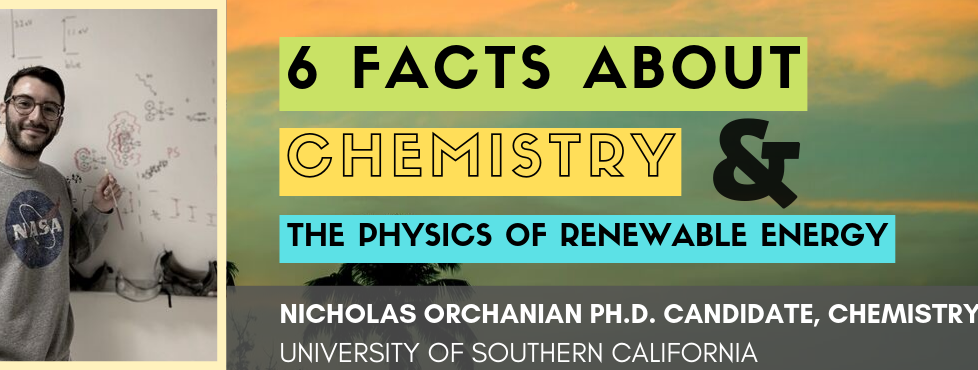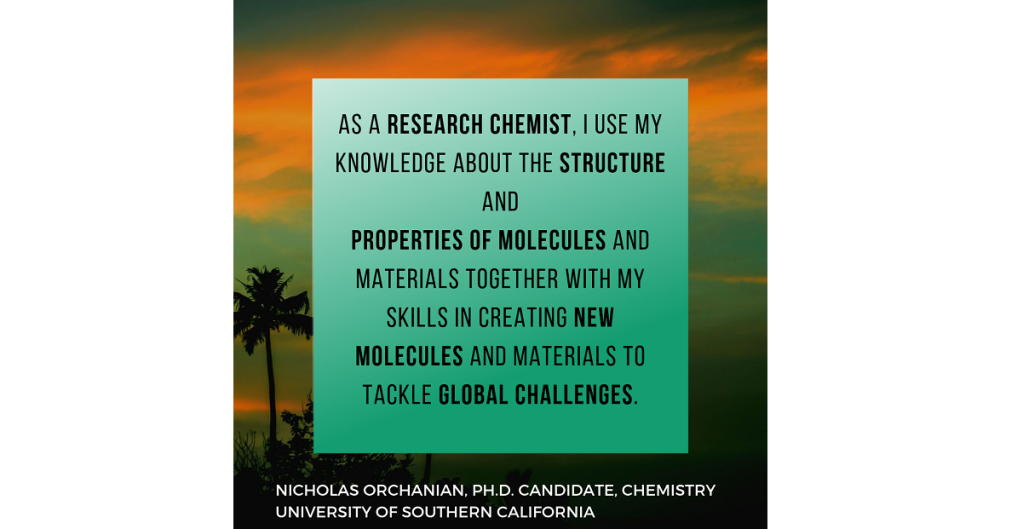PROFILE: Nicholas Orchanian, Ph.D. Candidate, Chemistry

We Rep STEM aims to promote the work of inspiring people in the STEM community. Today, we’re featuring Nicholas Orchanian, a Ph.D. candidate in chemistry at the Univeristy of Southern California.
Read on to learn more about Nicholas and what his work entails, in his own words.

Hello! My name is Nicholas Orchanian and I’m a Ph.D. candidate in chemistry at the University of Southern California (Fight On!)
As a research chemist, I use my knowledge about the structure and properties of molecules and materials together with my skills in creating new molecules and materials to tackle global challenges.
In particular, I’ve always been amazed by the electricity grid and how our modern society can power all the amazing new technologies and devices we use today. As a member of the Marinescu Lab at USC, I work on developing new ways to incorporate solar energy into the grid through “artificial photosynthesis.”
To do this, I design new molecules and materials that can capture carbon dioxide from the atmosphere and transform it into the chemicals we use to fuel our planet, in analogy to the way plants recycle CO2 through photosynthesis.

Here are some amazing facts about the chemistry and physics of renewable energy:
1) More solar energy strikes the Earth in 1 hour than the entire planet uses in a year.
2) Solar energy is free, renewable, and available to everyone on the planet! This makes it especially attractive since it means we don’t have to rely on other countries to ship oil to us.
3) We already use solar energy! Every time you fill up your car with gasoline, you’re actually pumping solar energy into it! Ancient plants used photosynthesis to combine carbon dioxide, water, and sunlight to construct themselves. Over millions of years, the bodies of these plants have been compacted into the fuel that we use today.
4) Plants are very inefficient at storing solar energy. Since plants need to use energy to keep themselves alive, only a small amount of captured sunlight gets converted to useful products. That’s why chemists are designing new systems that can carry out photosynthesis with higher efficiency.
5) Solar panels are 99% cheaper today than they were in the 70s, which means incorporating more solar energy into the grid mostly depends now on developing new ways to store it (like batteries or photosynthesis)
6) Solar energy is already cheaper than fossil fuels! With lower solar panel costs and higher-efficiency solar cells, the world is moving more quickly towards abandoning our dependence on fossil fuels.

For more information, you can check out our group website (marinescu.usc.edu) to read about our recent results or visit energy.gov to learn more about the renewable energy industry and how scientific research is making an impact.
Follow me on Twitter (@norchanian) or Instagram (@nickohlodeon) for fun facts about science, updates on my research, and a look into what life is like as a scientist!
If you’d like to have your work featured on We Rep STEM, get in touch! We can be reached via email at werepstem@gmail.com.
EDITOR’S NOTE: Minor grammatical edits were made to the original text.
Photo courtesy of Nicholas Orchanian.
